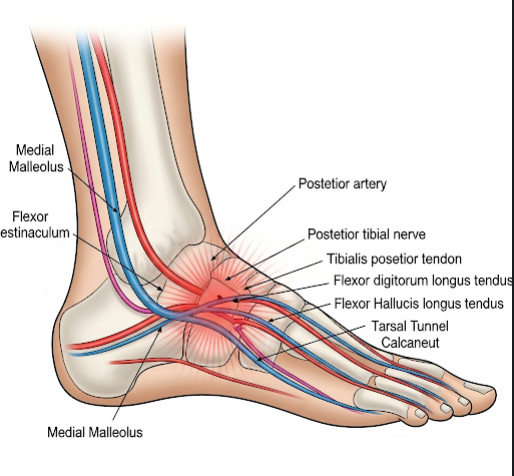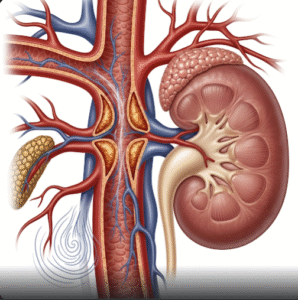Overview
Tarsal Tunnel Syndrome (TTS) is a condition caused by compression of the posterior tibial nerve as it passes through the tarsal tunnel—a narrow space located on the inside of the ankle. This nerve entrapment leads to pain, numbness, and tingling in the foot and ankle, which can significantly affect mobility and daily activities. TTS is often underdiagnosed but is gaining more recognition in South Korea thanks to improved diagnostic imaging and specialized orthopedic and neurological care. Patients benefit from a range of treatment options, from conservative management to advanced surgical interventions.
What is Tarsal Tunnel Syndrome?
Tarsal Tunnel Syndrome is similar in mechanism to carpal tunnel syndrome of the wrist, but it affects the ankle area. The tarsal tunnel is formed by bones and a fibrous band called the flexor retinaculum, which holds tendons, blood vessels, and nerves in place. When the posterior tibial nerve is compressed or irritated within this tunnel, it results in sensory disturbances and sometimes muscle weakness in the foot. The syndrome can be caused by trauma, inflammation, space-occupying lesions, or biomechanical abnormalities.
Symptoms
The symptoms of Tarsal Tunnel Syndrome typically include:
- Burning, tingling, or “pins and needles” sensation on the sole of the foot
- Numbness or decreased sensation in the foot and toes
- Sharp, shooting pain that can radiate up the leg
- Swelling or tenderness along the inside of the ankle
- Symptoms often worsen with prolonged standing, walking, or at night
- Weakness or cramping in foot muscles in severe cases
Causes
Several factors can cause or contribute to Tarsal Tunnel Syndrome:
- Trauma or injury: Ankle sprains, fractures, or repetitive strain injuries that cause swelling or scarring in the tarsal tunnel
- Biomechanical abnormalities: Flat feet or excessive pronation that put pressure on the nerve
- Space-occupying lesions: Ganglion cysts, lipomas, varicose veins, or bone spurs within the tunnel
- Inflammatory conditions: Arthritis or tenosynovitis causing swelling in adjacent tissues
- Systemic diseases: Diabetes mellitus or peripheral neuropathy increasing nerve susceptibility
- Postural issues: Improper footwear or gait abnormalities
Risk Factors
Factors increasing the likelihood of developing Tarsal Tunnel Syndrome include:
- History of ankle injuries or surgeries
- Flat feet or fallen arches
- Obesity, which increases pressure on the foot
- Occupations requiring prolonged standing or walking
- Diabetes and other systemic conditions causing nerve damage
- Age, as nerve elasticity decreases over time
Complications
If left untreated, TTS can lead to:
- Chronic pain and numbness impairing daily activities
- Muscle weakness leading to foot deformities
- Permanent nerve damage causing loss of sensation
- Gait abnormalities increasing the risk of falls and secondary injuries
Prevention
Preventive measures for Tarsal Tunnel Syndrome focus on reducing nerve compression and protecting foot health:
- Wearing supportive footwear with proper arch support
- Avoiding repetitive strain or excessive pressure on the ankle
- Maintaining a healthy weight to reduce foot stress
- Prompt treatment of ankle injuries to prevent swelling and scar tissue
- Managing systemic conditions like diabetes to protect nerves
- Regular foot exercises to maintain flexibility and strength
Treatment Options in Korea
South Korea provides advanced multidisciplinary care for Tarsal Tunnel Syndrome, with both conservative and surgical approaches:
Diagnosis
- Detailed patient history and physical examination including Tinel’s sign over the tarsal tunnel
- Nerve conduction studies and electromyography (EMG) to evaluate nerve function
- Imaging such as ultrasound or MRI to detect structural causes like cysts or inflammation
Conservative Treatments
- Rest and activity modification to reduce nerve irritation
- Nonsteroidal anti-inflammatory drugs (NSAIDs) for pain and inflammation
- Orthotic devices or custom-made shoe inserts to correct foot biomechanics
- Physical therapy focusing on stretching, strengthening, and nerve gliding exercises
- Corticosteroid injections for localized inflammation
Surgical Treatment
- Tarsal tunnel release surgery to decompress the posterior tibial nerve by cutting the flexor retinaculum
- Removal of space-occupying lesions if identified
- Postoperative rehabilitation to restore function and prevent scar tissue formation
Complementary Therapies
- Traditional Korean medicine approaches such as acupuncture and herbal treatments may aid symptom relief and nerve healing
Rehabilitation and Support
- Guidance on footwear and lifestyle modifications
- Regular follow-up with orthopedic specialists and physiotherapists
- Patient education on symptom management and prevention of recurrence
Leading Medical Centers for Tarsal Tunnel Syndrome in Korea
- Seoul National University Hospital
- Asan Medical Center
- Samsung Medical Center
- Korea University Anam Hospital
These centers offer state-of-the-art diagnostics and personalized treatment plans combining modern medicine with integrative approaches.













